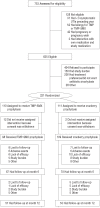Cost-effectiveness of cranberries vs antibiotics to prevent urinary tract infections in premenopausal women: a randomized clinical trial
- PMID: 24705418
- PMCID: PMC3976255
- DOI: 10.1371/journal.pone.0091939
Cost-effectiveness of cranberries vs antibiotics to prevent urinary tract infections in premenopausal women: a randomized clinical trial
Abstract
Background: Urinary tract infections (UTIs) are common and result in an enormous economic burden. The increasing prevalence of antibiotic-resistant microorganisms has stimulated interest in non-antibiotic agents to prevent UTIs.
Objective: To evaluate the cost-effectiveness of cranberry prophylaxis compared to antibiotic prophylaxis with trimethoprim-sulfamethoxazole (TMP-SMX) over a 12 month period in premenopausal women with recurrent UTIs.
Materials and methods: An economic evaluation was performed alongside a randomized trial. Primary outcome was the number of UTIs during 12 months. Secondary outcomes included satisfaction and quality of life. Healthcare utilization was measured using questionnaires. Missing data were imputed using multiple imputation. Bootstrapping was used to evaluate the cost-effectiveness of the treatments.
Results: Cranberry prophylaxis was less effective than TMP-SMX prophylaxis, but the differences in clinical outcomes were not statistically significant. Costs after 12 months in the cranberry group were statistically significantly higher than in the TMP-SMX group (mean difference €249, 95% confidence interval 70 to 516). Cost-effectiveness planes and cost-effectiveness acceptability curves showed that cranberry prophylaxis to prevent UTIs is less effective and more expensive than (dominated by) TMP-SMX prophylaxis.
Conclusion: In premenopausal women with recurrent UTIs, cranberry prophylaxis is not cost-effective compared to TMP-SMX prophylaxis. However, it was not possible to take into account costs attributed to increased antibiotic resistance within the framework of this randomized trial; modeling studies are recommended to investigate these costs. Moreover, although we based the dosage of cranberry extract on available evidence, this may not be the optimal dosage. Results may change when this optimal dosage is identified.
Trial registration: ISRCTN.org ISRCTN50717094.
Conflict of interest statement
Figures



Similar articles
-
Cranberries vs antibiotics to prevent urinary tract infections: a randomized double-blind noninferiority trial in premenopausal women.Arch Intern Med. 2011 Jul 25;171(14):1270-8. doi: 10.1001/archinternmed.2011.306. Arch Intern Med. 2011. PMID: 21788542 Clinical Trial.
-
Bladder infection: Do herbal remedies help with recurrent bladder infection? IQWiG Reports – Commission No. HT20-01 [Internet].Cologne (Germany): Institute for Quality and Efficiency in Health Care (IQWiG); 2022 Feb 24. Cologne (Germany): Institute for Quality and Efficiency in Health Care (IQWiG); 2022 Feb 24. PMID: 37023241 Free Books & Documents. Review.
-
Continuous low-dose antibiotic prophylaxis for adults with repeated urinary tract infections (AnTIC): a randomised, open-label trial.Lancet Infect Dis. 2018 Sep;18(9):957-968. doi: 10.1016/S1473-3099(18)30279-2. Epub 2018 Jun 28. Lancet Infect Dis. 2018. PMID: 30037647 Free PMC article. Clinical Trial.
-
Prophylaxis for recurrent urinary tract infections: nitrofurantoin, not trimethoprim-sulfamethoxazole or cranberry juice.Arch Intern Med. 2012 Jan 9;172(1):82; author reply 82-3. doi: 10.1001/archinternmed.2011.613. Arch Intern Med. 2012. PMID: 22232158 No abstract available.
-
Current clinical status on the preventive effects of cranberry consumption against urinary tract infections.Nutr Res. 2013 Aug;33(8):595-607. doi: 10.1016/j.nutres.2013.05.018. Epub 2013 Jul 1. Nutr Res. 2013. PMID: 23890348 Review.
Cited by
-
Cranberries for preventing urinary tract infections.Cochrane Database Syst Rev. 2023 Nov 10;11(11):CD001321. doi: 10.1002/14651858.CD001321.pub7. Cochrane Database Syst Rev. 2023. PMID: 37947276 Free PMC article.
-
Cost-Effectiveness of a Sublingual Bacterial Vaccine for the Prophylaxis of Recurrent Urinary Tract Infections.Urol Int. 2022;106(7):730-736. doi: 10.1159/000521772. Epub 2022 Feb 7. Urol Int. 2022. PMID: 35130558 Free PMC article.
-
Segmental Acupuncture for Prevention of Recurrent Urinary Tract Infections. A Randomised Clinical Trial.Int Urogynecol J. 2024 Aug;35(8):1689-1697. doi: 10.1007/s00192-024-05872-7. Epub 2024 Jul 25. Int Urogynecol J. 2024. PMID: 39060726 Free PMC article. Clinical Trial.
-
Novel Strategies in the Prevention and Treatment of Urinary Tract Infections.Pathogens. 2016 Jan 27;5(1):13. doi: 10.3390/pathogens5010013. Pathogens. 2016. PMID: 26828523 Free PMC article. Review.
-
Cranberries for preventing urinary tract infections.Cochrane Database Syst Rev. 2023 Apr 17;4(4):CD001321. doi: 10.1002/14651858.CD001321.pub6. Cochrane Database Syst Rev. 2023. Update in: Cochrane Database Syst Rev. 2023 Nov 10;11:CD001321. doi: 10.1002/14651858.CD001321.pub7. PMID: 37068952 Free PMC article. Updated.
References
-
- Foxman B (2002) Epidemiology of urinary tract infections: incidence, morbidity, and economic costs. Am J Med 113 (Suppl 1A) 5S–13S. - PubMed
-
- Clayson D, Wild D, Doll H, Keating K, Gondek K (2005) Validation of a patient-administered questionnaire to measure the severity and bothersomeness of lower urinary tract symptoms in uncomplicated urinary tract infection (UTI): the UTI Symptom Assessment questionnaire. BJU Int 96: 350–359. - PubMed
-
- Colgan R, Keating K, Dougouih M (2004) Survey of symptom burden in women with uncomplicated urinary tract infections. Clin Drug Investig 24: 55–60. - PubMed
-
- Ellis AK, Verma S (2000) Quality of life in women with urinary tract infections: is benign disease a misnomer? J Am Board Fam Pract 13: 392–397. - PubMed
-
- Malterud K, Baerheim A (1999) Peeing barbed wire. Symptom experiences in women with lower urinary tract infection. Scand J Prim Health Care 17: 49–53. - PubMed
Publication types
MeSH terms
Substances
Associated data
LinkOut - more resources
Full Text Sources
Other Literature Sources
Medical

